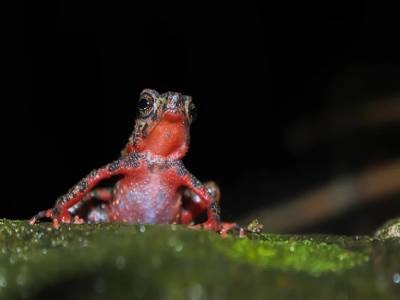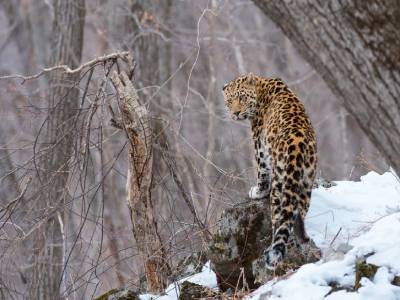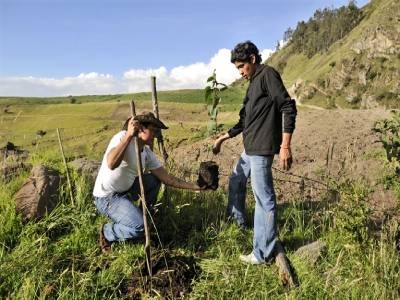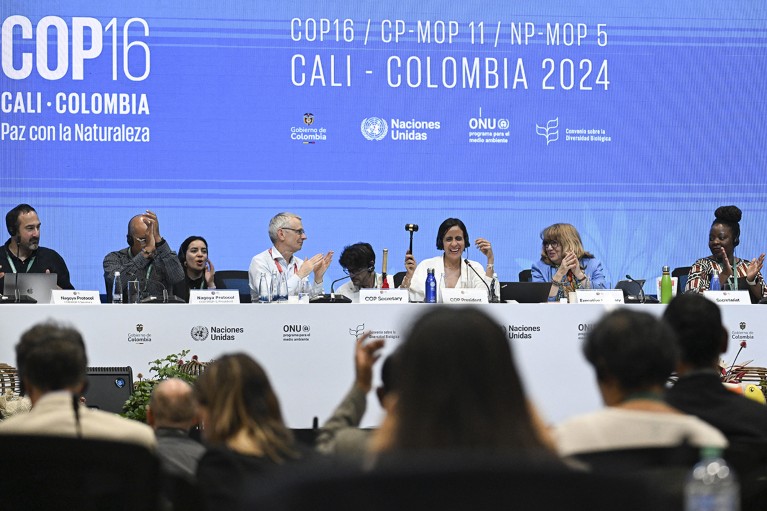
The last plenary session of the COP16 biodiversity summit in Cali, Colombia, wrapped up on 2 November.Credit: Joaquin Sarmiento/AFP via Getty
Two years ago, after more than 190 countries at a United Nations summit made a historic pledge to protect the world’s species, questions arose about whether they could afford to keep that promise. At the latest meeting — held in Cali, Colombia, over the past two weeks — fights about conservation funding took centre stage, with little resolution.
Can the world save a million species from extinction?
But there were some bright spots. One was that negotiators approved an agreement that paves the way for large companies to pay for the use of digital genetic information extracted from nature, if it generates profit. For instance, a highly profitable agribusiness in the United Kingdom might use a digital DNA sequence from a plant found in Brazil to improve a crop. Under the agreement, that business will be encouraged to pay 1% of its profits or 0.1% of its revenue into a fund that could help countries such as Brazil to pay for conservation.
The agreement seemed far off before this year’s summit. Civil-society groups and researchers are calling it a crucial victory in the face of rapid decline in global biodiversity.
“It is a voluntary mechanism, so there’s everything to be seen about how we get that to work and make sure companies are doing it,” says Yadvinder Malhi, an ecosystems researcher at the University of Oxford, UK. But “it is a big, big win, and we have to go further with it”.
Species threatened
Research released during the Cali summit, called the 16th Conference of the Parties to the Convention on Biological Diversity (COP16), highlighted the urgent need for action on biodiversity.
For instance, the International Union for Conservation of Nature, based in Gland, Switzerland, reported that more than one in three tree species is now at risk of extinction, and the conservation organization WWF, also based in Gland, reported that the average size of the globe’s wildlife populations has declined by 73% in 50 years.
10 startling images of nature in crisis — and the struggle to save it
“We are already at a tipping point, and the change to these ecosystems will be irreversible” if action isn’t taken, says Manuel Pulgar-Vidal, the global leader of climate and energy at the WWF.
Yet many researchers were frustrated by what they saw as a lack of progress at COP16. By the close of the summit, only 44 of the 190-plus countries that signed the biodiversity deal two years ago had submitted action plans. And although around US$163 million was pledged in Cali to protect and restore nature, that amount is well short of the $200 billion per year that nations agreed will be needed to attain the goal of protecting 30% of the world’s land and seas by 2030.
With nations not yet spending the sums required, there is growing pressure to seek funding from the private sector.
Paying for knowledge
For example, in the agreement to pay for genetic information from nature, otherwise known as digital sequence information (DSI), highly profitable companies are asked to contribute to the conservation ‘Cali Fund’. To be tapped for money, these firms have to hit two of three criteria: they must have $20 million in assets per year, make $50 million in sales per year or make $5 million in profit annually, averaged over the preceding three years.
“Conservation is mostly funded by governments and philanthropy,” says Amber Hartman Scholz, head of the science-policy department at Leibniz Institute DSMZ in Braunschweig, Germany. “Now businesses that profit from biodiversity will pay.”
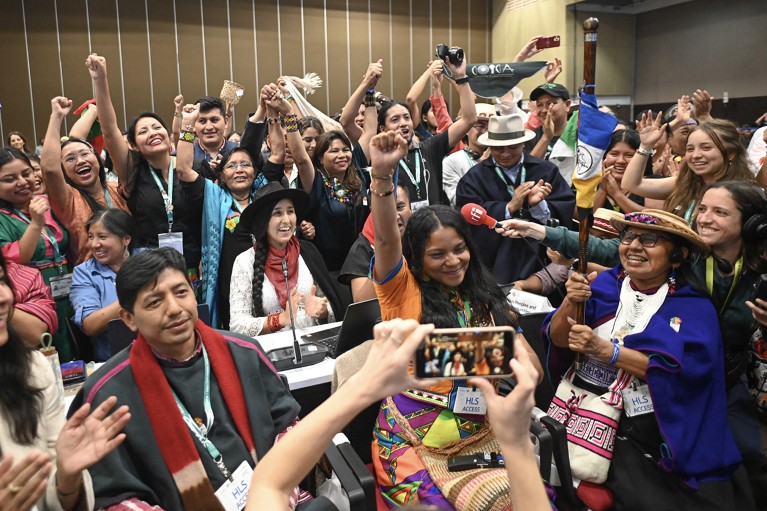
Members of Indigenous communities erupted in cheers at COP16 after a formal body representing their interests in biodiversity negotiations was created.Credit: Joaquin Sarmiento/AFP via Getty
If countries create strong legal frameworks to ensure that businesses comply, economic models show that the DSI agreement could bring in between $1 billion and $9 billion annually, Scholz adds.
“It’s a step in the right direction,” says Nathalie Seddon, an evolutionary ecologist at the University of Oxford. She is concerned that the agreement doesn’t obligate businesses to pay into the fund and instead leaves it to governments to ensure compliance. But she points out a bright spot: half of the Cali Fund has been earmarked for Indigenous people and local communities, who are often the stewards of land rich in biodiversity. (Negotiators at COP16 also agreed to establish a subsidiary body for Indigenous communities to represent their interests in future biodiversity conservation decisions.)
Putting a price on biodiversity
There was much more controversy over discussions of another way to coax businesses to financially support biodiversity conservation: the sale of biodiversity credits.
The idea is that companies could purchase biodiversity credits to improve their reputation, to ensure their own survival if they rely on nature-based products and to offset any harm that they are doing to Earth’s species with their operations. The credits would, in turn, pay for conservation projects globally.
How biodiversity credits could help to conserve and restore nature
During COP16, the International Advisory Panel on Biodiversity Credits (IAPB) — a group of 25 specialists in business, conservation and finance from around the world — published its guidelines on how to establish and scale up the scheme. But the release was met with criticism.
The plan has been compared with carbon credits, which companies can purchase to offset their release of greenhouse-gas emissions. Carbon credits have been derided for potential links to human-rights violations and for generating profits for intermediary businesses that sell the credits while failing to actually reduce emissions.
“Government donations are the only thing that’s put significant amounts of money towards nature, and those efforts are getting diminished by talk of selling biodiversity credits, which are convoluted, unproven and have no demand,” says Brian O’Donnell, director of the environmental-advocacy organization Campaign for Nature, who is based in Durango, Colorado.
According to a December 2023 report from the World Economic Forum, if biodiversity credits gain traction quickly like carbon credits, global demand for them could reach $2 billion per year by 2030 and $69 billion by 2050.
IAPB member Simon Zadek, chief executive of NatureFinance — a non-profit organization in Geneva, Switzerland, that is working to increase the role of finance in conservation — argues that the “disgrace” of voluntary carbon markets provides lessons that will make it possible to design a biodiversity-credit market that works.
For instance, says Zadek, the panel has recommended that there should be no secondary trading of biodiversity credits, as is done by intermediary companies in the carbon market. Instead, the panel proposes a national model in which businesses that damage nature are taxed by their government. The proceeds would buy national biodiversity credits to fund 20–25-year nature-restoration programmes.
If the IAPB does not push the creation of a market for biodiversity credits, “there is a real risk” that private firms, including those already involved in the carbon market, will go it alone with no oversight, Zadek says. This would “generate a mess”.

